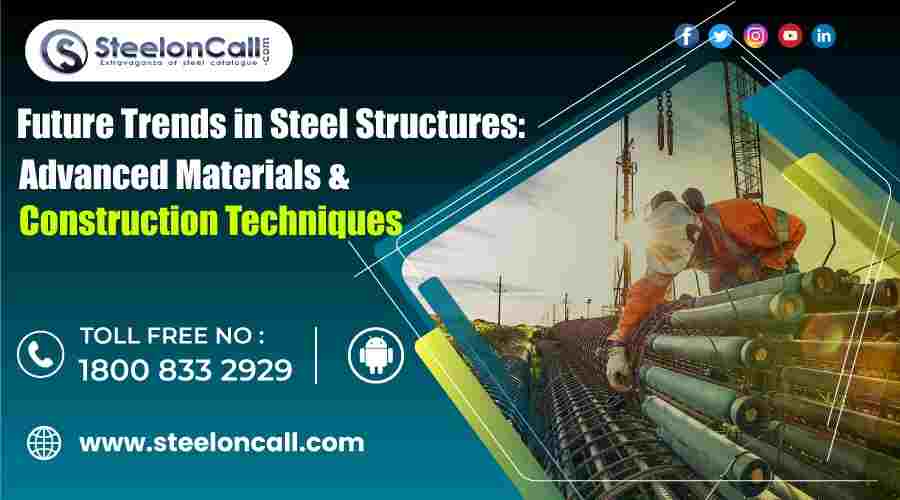Future Trends in Steel Structures: Advanced Materials & Construction Techniques

In the realm of construction, the adoption of advanced materials and construction techniques represents a pivotal shift toward innovation, efficiency, and sustainability. As industries evolve and societal demands change, the utilization of cutting-edge methods becomes not just a choice but a necessity. Here are compelling reasons why incorporating advanced materials and construction techniques is imperative for the future of construction:
1. Enhanced Structural Performance:
-
Materials Strength: Advanced materials often exhibit superior strength, durability, and resilience, ensuring structures can withstand diverse environmental conditions and stresses.
-
Innovative Composites: The integration of composite materials, combining different substances for optimized properties, allows for structures that outperform traditional ones.
2. Efficiency in Construction:
-
Prefabrication and Modular Construction: Techniques like prefabrication and modular construction streamline the building process, reducing construction time and labor costs.
-
3D Printing: Revolutionary 3D printing technologies enable the rapid and precise construction of complex structures, offering unprecedented efficiency.
3. Sustainability and Environmental Impact:
-
Green Building Practices: Advanced materials often align with green building standards, incorporating sustainable practices like the use of recycled materials and reduced energy consumption.
-
Carbon Footprint Reduction: Construction techniques that focus on sustainability contribute to lowering the overall carbon footprint of buildings and infrastructure.
Future Trends in Steel Structures:
As the world strides into the future, the domain of steel construction stands on the cusp of remarkable advancements. Pioneering materials and innovative construction techniques are reshaping the narrative of steel structures, ushering in an era of unparalleled engineering excellence.
Evolution of Steel Structures: A Historical Prelude
Steel, a cornerstone in construction for centuries, has undergone a transformative journey, impacting the design and construction of buildings. From the early use of cast iron in the 6th century BCE to the revolutionary Bessemer process in the mid-19th century, the evolution of steel has been marked by technological leaps and innovative design paradigms.
Key Milestones:
Steel Frame System (Late 19th Century):
-
The introduction of steel columns and beams allowed for taller and more robust structures.
-
Iconic structures like the Eiffel Tower showcased the potential of steel in architectural design.
20th Century Advancements:
-
The development of new steel alloys and fabrication techniques enhanced strength and versatility.
-
Structural steel shapes like the I-beam and welding advancements led to more efficient construction.
Recent Trends: A Focus on Sustainability and Innovation
Recycled Steel Usage:
-
The growing prominence of recycled steel reduces the environmental impact of production.
Innovative Design Techniques:
-
Integration of steel with materials like glass and concrete for visually stunning and structurally efficient buildings.
Technological Integration:
-
Utilization of Computer-Aided Design (CAD) and Building Information Modeling (BIM) optimizes structural performance.
-
Intelligent technologies such as sensors enable real-time assessment of structural integrity.
Future Applications of Steel Structures: Embracing Advancements
Advanced Composite Materials:
-
Integration of materials with higher strength-to-weight ratios for lighter and more durable structures.
-
TMT bars complement composite materials, providing essential tensile strength.
Smart and Responsive Structures:
-
Integration of sensor technology for real-time structural health monitoring.
-
Proactive maintenance and early defect detection enhance safety.
3D Printing of Steel Structures:
-
Revolutionary additive manufacturing techniques for on-site construction.
-
Potential for complex and customized designs with reduced transportation needs.
Self-Healing Steel:
-
Exploration of materials capable of automatic repair, extending the lifespan and reducing maintenance costs.
Energy Harvesting and Efficiency:
-
Integration of renewable energy sources, such as solar panels, into steel structures.
-
Focus on advanced insulation and energy-efficient designs for improved performance.
Multi-Functional Structures:
-
Designs that serve multiple purposes, maximizing land use and promoting sustainability.
-
Examples include bridges with integrated transportation systems or buildings with green spaces.
Modular and Adaptable Designs:
-
Inherent flexibility for easy expansion, modification, or relocation, reducing waste and improving scalability.
Integration of Robotics and Automation:
-
Increased use of robotics and automation for precision tasks, enhancing safety and project completion speed.
Challenges and Opportunities: Navigating the Path Forward
Sustainability and Environmental Concerns:
-
Challenge: Addressing the carbon footprint.
-
Opportunity: Development of low-carbon steel production and eco-friendly practices.
Digitalization and BIM:
-
Challenge: Significant investment in technology and training.
-
Opportunity: Enhanced efficiency, reduced errors, and streamlined communication.
Advanced Materials and Manufacturing Techniques:
-
Challenge: Optimization for large-scale applications and quality control.
-
Opportunity: Improved structural performance and cost-effectiveness.
Resilience and Safety:
-
Challenge: Balancing cost-effectiveness with design complexity.
-
Opportunity: Integration of resilient design principles for safety and continuous improvement.
Conclusion: Forging a Future of Steel Innovation
The trajectory of steel structures unfolds with a narrative of sustainability, innovation, and technological prowess. As the construction industry embraces advancements in materials and techniques, the future of steel structures promises to be safer, greener, and more efficient. In this synthesis of tradition and innovation, steel structures stand as testaments to human ingenuity, adapting to the evolving needs of a dynamic world.

